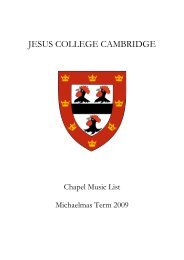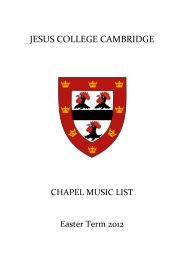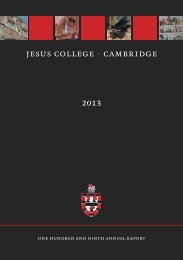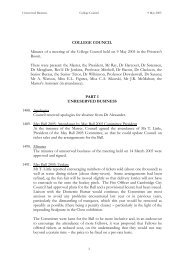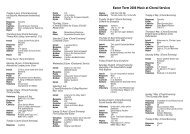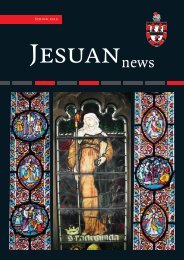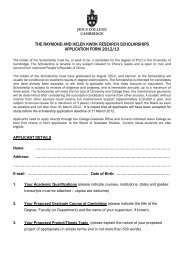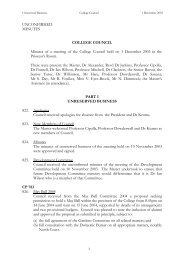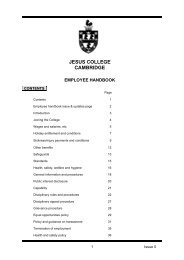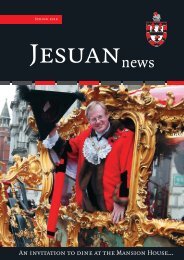2012 Annual Report - Jesus College - University of Cambridge
2012 Annual Report - Jesus College - University of Cambridge
2012 Annual Report - Jesus College - University of Cambridge
You also want an ePaper? Increase the reach of your titles
YUMPU automatically turns print PDFs into web optimized ePapers that Google loves.
122 OBITUARIES I <strong>Jesus</strong> <strong>College</strong> <strong>Annual</strong> <strong>Report</strong> <strong>2012</strong><br />
ahead <strong>of</strong> its time. It contributed greatly to transforming a hitherto rather qualitative<br />
treatment <strong>of</strong> the subject into a quantitative and rigorous approach. Alan was a brilliant<br />
lecturer, able to convey quite complex phenomena in simple terms.<br />
After the war Alan started research on the plastic properties <strong>of</strong> metals. In a series <strong>of</strong><br />
penetrating and elegant, now classic, studies he showed inter alia how certain crystal<br />
defects called dislocations determined some important unique features in the ductile<br />
behaviour <strong>of</strong> structural steels, and how their interactions controlled hardening <strong>of</strong> metals<br />
by cold working. His contributions in this field are second to none.<br />
Alan’s work contributed much to making the Birmingham Department famous as a<br />
leading centre for the science <strong>of</strong> metals. Alan was given a personal Pr<strong>of</strong>essorship in 1949<br />
at the age <strong>of</strong> 30, and in 1955 was elected to The Royal Society at the early age <strong>of</strong> 35. In<br />
1955 Alan was invited by Monty Finniston to join him as Deputy Head <strong>of</strong> the Metallurgy<br />
Division at Harwell. He accepted because he expected to find problems there <strong>of</strong> national<br />
importance which fell into his field. One <strong>of</strong> his pioneering researches there, on neutron<br />
irradiated metals, led to a redesign <strong>of</strong> the fuel rods in Magnox Civil Nuclear Reactors.<br />
On 10th October 1957 a reactor at Windscale caught fire and started a national<br />
emergency. It occurred during a gentle heating to anneal the damage in the graphite<br />
core. Unfortunately, the energy released in this process heated up the graphite so much<br />
that it caught fire. Alan set up a new laboratory in just two weeks and he and his team<br />
unravelled the problem and were able to give an assurance that the Magnox reactors<br />
would be immune to this self heating effect.<br />
In 1958 Alan accepted an invitation to become Head <strong>of</strong> Department <strong>of</strong> Metallurgy at<br />
<strong>Cambridge</strong>. He modernised the Department by bringing in new people (Robin<br />
Nicholson, Tony Kelly, Jim Charles, and later Graeme Davies) and new equipment, and<br />
by teaching the subject from the atomic point <strong>of</strong> view. He also started two new research<br />
projects, on field-ion microscopy, and on superconducting alloys. His own researches<br />
focussed on brittle fracture <strong>of</strong> structural steel at freezing temperatures, responsible for<br />
many tragic accidents to ships and bridges, and secondly, with Tony Kelly, on the<br />
physics <strong>of</strong> fibrous composites. This led to the development <strong>of</strong> new materials such as<br />
fibreglass and carbon fibre. Alan’s work on fracture identified a toughness parameter<br />
for a metal containing a crack, which was characteristic <strong>of</strong> the material, and which,<br />
when measured in a test piece, could be used to predict behaviour in a large structure.<br />
This represented an important advance in understanding and in ensuring structural<br />
integrity, and had an enormous impact in this field.<br />
All these changes in teaching and research activities transformed the Department into<br />
a world class institution. It has remained so ever since.<br />
In 1964 Alan accepted an invitation to become Sir Solly Zuckerman’s Deputy in the<br />
Ministry <strong>of</strong> Defence. Although most reluctant to leave the Department and the<br />
<strong>University</strong>, he had become concerned with the need to invigorate British Manufacturing<br />
Industry with Scientific Technology, and felt that Whitehall was the place to do this.<br />
Working on Dennis Healey’s defence review, Alan led tri-services studies on the<br />
problems, in particular the excessive cost, <strong>of</strong> a military presence in the near and far East.<br />
This led to the cancellation <strong>of</strong> the Government’s East <strong>of</strong> Suez Policy. In 1966 he followed<br />
Solly to the Cabinet Office as Deputy Chief Scientific Advisor. There he tackled various<br />
problems with scientific aspect, including the brain drain, environment and pollution,<br />
the Advanced Passenger Train and the Torrey Canyon disaster, but efforts to transfer<br />
some government defence research funding to research in civil industry failed, because<br />
the Treasury was interested only in reducing research funding.<br />
In 1971 Alan was knighted and became Chief Scientific Advisor. His position became<br />
complicated by the arrival <strong>of</strong> Victor Rothschild and his Central Policy Review staff.



